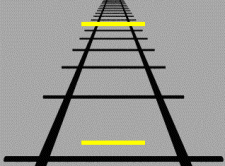Ponzo illusion
The Ponzo illusion is an optical illusion that was first demonstrated by the Italian psychologist Mario Ponzo (1882-1960) in 1913. He suggested that the human mind judges an object's size based on its background. He showed this by drawing two identical lines across a pair of converging lines, similar to railway tracks. The upper line looks longer because we interpret the converging sides according to linear perspective as parallel lines receding into the distance. In this context, we interpret the upper line as though it were farther away, so we see it as longer – a farther object would have to be longer than a nearer one for both to produce retinal images of the same size.
Some researchers believe that the Moon illusion is an example of the Ponzo illusion [1], with trees and houses playing the role of Ponzo's converging lines. Foreground objects trick our brain into thinking the moon is bigger than it really is.
One of the explanations for Ponzo illusion is the 'Perspective hypothesis', which states that the perspective feature in the figure is obviously produced by the converging lines ordinarily associated with distance, that is, the two oblique lines appear to converge toward the horizon or a vanishing point. Another is the 'Framing effects hypothesis', which says that the difference in the separation or gap of the horizontal lines from the framing converging lines may determine, or at least contribute to the magnitude of the distortion.
This typical visual illusion also occurs in touch and with an audition-to-vision sensory substitution device. However, prior visual experience seems mandatory to perceive it as demonstrated by the fact that congenitally blind subjects are not sensitive to it.
- Renier, L., De Volder, A.G. Cognitive and brain mechanisms in sensory substitution of vision: a contribution to the study of human perception. Journal of Integrative Neuroscience, Special Edition in Honor of Paul Bach-y-Rita, 2005, 4 : 489-503. http://www.worldscinet.com/179/04/0404/S0219635205000999.html
- Renier, L., Laloyaux, C., Collignon, O., Tranduy, D., Vanlierde, A., Bruyer, R.,De Volder A.G. (2005). The Ponzo illusion using auditory substitution of vision in sighted and early blind subjects. Perception, 34, 857–867. http://www.perceptionweb.com/perabs/p34/p5219.html
Credits
New World Encyclopedia writers and editors rewrote and completed the Wikipedia article in accordance with New World Encyclopedia standards. This article abides by terms of the Creative Commons CC-by-sa 3.0 License (CC-by-sa), which may be used and disseminated with proper attribution. Credit is due under the terms of this license that can reference both the New World Encyclopedia contributors and the selfless volunteer contributors of the Wikimedia Foundation. To cite this article click here for a list of acceptable citing formats.The history of earlier contributions by wikipedians is accessible to researchers here:
The history of this article since it was imported to New World Encyclopedia:
Note: Some restrictions may apply to use of individual images which are separately licensed.
